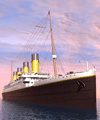February
A small ship with a Titanic reputation – why RMS Titanic is no longer the ship she once was

Despite conjuring up images of vastness and opulence, Titanic was actually no bigger than a North Sea ferry and could easily sit on the deck of a large container ship.
Now Paul Stott, a Senior Lecturer in the School of Marine Science and Technology, says we need to move on from the romanticised, over-inflated images of Titanic and find a more meaningful benchmark against which to convey ship size in the popular press.
“The reality is that - even if any living person had seen the Titanic – it would not be particularly large in the modern context,” he explains.
“Whilst large in her day, Titanic would be equivalent only to a mid-sized ferry in the modern era, the sort of ship many have sailed on to get to France or Holland, and this normally comes as a revelation.
“Its size was exceeded by a factor of two with the Queen Mary in 1936, almost 80 years ago, and it is no more than 20% of the size of the largest ship currently afloat.”
Publishing this month in the academic journal Mariner’s Mirror, Mr Stott discusses the issue of size in relation to the mammoth salvage operation currently underway off the West coast of Italy to recover the Costa Concordia.
“In reporting this, the press almost universally reached to the RMS Titanic to provide a benchmark to try to convey the size of the object with which salvors were grappling with,” explains Mr Stott.
“Stating that the Costa Concordia is around twice the size of the Titanic, gives a vague impression that they were trying to move a large object, but not in any tangible way that can give a direct sense of the scale because none of us have actually seen Titanic.”
Finding a new benchmark
Benchmarking ship size in the popular context is a complex task. Obvious measures such as length and weight do not do justice to the physical size of ships and weight is unreliable because of the varying nature of different designs of ship.
“Whilst the Costa Concordia is more than double the physical size of Titanic, their weights are very similar (around 55,000 tonnes) because modern designs are inherently much lighter than Edwardian engineering,” explains Mr Stott.
Linear parameters were tried as well as weight but none convey the right message about how heroic the salvage effort is. “Stating that the Costa Concordia is equivalent in length to 26 London buses conveys no impression of the size of a cruise ship. The comparator has to be volumetric”.
The research shows that none of the usual volume comparators, such as the use of Olympic sized swimming pools, are of any use. The research does, however, identify benchmarks that can be used to convey the correct impression of modern large ships.
“Stating that the Costa Concordia is around twice the size of St Paul’s Cathedral in London, in terms of their physical size, conveys in a direct way how large the object is that salvors are attempting to move.
“It also turns out that the Costa Concordia is equivalent in size to the Gherkin in London,” adds Mr Stott. “Stating that the salvors are using brute force to move an object the size of a sky scraper, which many have seen and can therefore relate to directly, really gets across the message of how heroic the operation is.”
Source Information: “The Use of Benchmarks in the Popular Reporting of Commercial Shipping: Is the Titanic an appropriate measure to convey the size of a modern ship?” Paul Stott. Mariner’s Mirror
DOI: http://dx.doi.org/10.1080/00253359.2014.866378
published on: 11 February 2014
